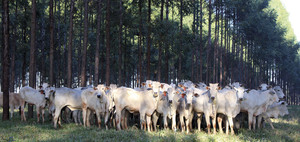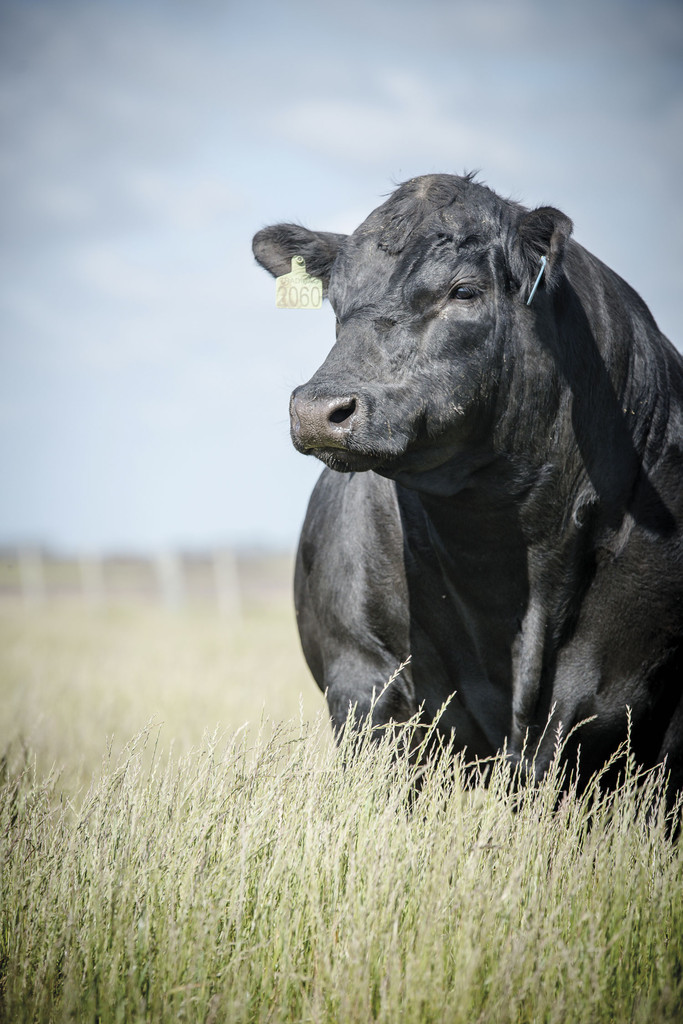
EMBRAPA
Nelore cattle herds on the Brazilian Agricultural Research Corporation (EMBRAPA) farm in São Carlos: complete gene and protein sequencing to determine individual differencesEMBRAPAStudies on selective breeding based on the identification and manipulation of genes and proteins are currently underway in Brazil in order to improve the quality of beef cattle. The goal is to develop cattle with greater feeding efficiency—the ability to transform what they eat into meat and fat—as well as cattle which exhibit faster weight gain, resistance to parasites and diseases, and more tender meat. This selective breeding was initially performed using only the animals’ visible features, but the information encoded in their genes has been found to aid in the selection of cattle with the qualities desired for meat production. Most studies are performed on the Nelore breed of the zebu subspecies (Bos taurus indicus), which originated in India and which makes up 80% of Brazil’s cattle herds.
An analysis of the structural and functional variations in the Nelore genome and their associations with production-related traits, such as meat quality and the breed’s feeding efficiency, has been carried out by veterinarian Luciana Correia de Almeida Regitano, an animal genetics researcher from EMBRAPA Livestock Southeast, one of the branches of the Brazilian Agricultural Research Corporation (EMBRAPA) located in the city of São Carlos, São Paulo. “The goal is to understand the molecular mechanisms that contribute to genetic variation and which affect the animal’s phenotype [an individual’s set of observable characteristics].” Using this information, farmers can select animals that exhibit favorable characteristics or can even induce mutations in the animal’s genome, thus improving the breed’s traits.
One of the studies conducted by Regitano’s group examines the KCNJ11 gene. In mice, the lack of expression of this gene leads to low food use and muscle weakness. “When we investigated the function of this gene in cattle, we found it to be associated with meat tenderness,” Regitano explains. “The animals with reduced expression of this gene were found to have more tender meat, but they also exhibited lower hay consumption, lower daily weight gain, and lower rates of growth. These results show how interfering in the expression of a single gene can have both positive and negative results from the farmer’s point of view.”
In Brazil, these studies have become particularly important: the country is the second largest cattle producer in the world, with 215.2 million head in 2015, coming in second only to India, with 330 million head in 2014. Zebu cattle, which are the dominant subspecies in Brazil, are adapted to tropical climates in that they are more resistant to diseases and to weaker pastures. Good, tender meat is associated with higher fat content, which occurs in the subspecies Bos Taurus taurus, of European origin.

Eduardo Cesar
The bovine DNA chip is a blade with sensors that is used to determine familial relationships within a group of animals, as well as to identify genetic defectsEduardo CesarComparisons between Angus (the most common European breed raised in Brazil, particularly in the south of the country) and Nelore meat are one way to understand what distinguishes them beyond the higher fat content in the European breed. This was the focus of the doctoral dissertation by veterinarian Rafael Torres de Souza Rodrigues from the Federal University of Lavras (UFLA) in Minas Gerais State. “We want to know why European cattle meat is more tender and has more intramuscular fat than zebu cattle meat.” The researcher, now working on his PhD at the Federal University of Vale do São Francisco (UNIVASF) in the city of Petrolina, Pernambuco, compared the proteomes (sets of proteins) from the muscles of these breeds soon after slaughter. “Because proteins make up most of the muscle tissue, and because they are responsible for tenderizing meat after the slaughter, the difference in the abundance of specific proteins between the two breeds may explain why one is more tender than the other,” Rodrigues explains. He found evidence that the difference in meat tenderness is associated with the same mechanisms that guide apoptosis, or programmed cell death. This mechanism is triggered by cellular stress, which itself is caused by factors such as a lack of oxygen or glucose and a drop in pH, all of which occur after the animal dies.
“In recent years, this biochemical process has been found to be responsible for coordinating meat tenderizing after the slaughter,” Rodrigues says. Currently, the difference in meat tenderness between zebus and taurus cattle is largely attributed to the zebu subspecies’ higher activity of a protein known as calpastatin. “This protein inhibits calpain activity. Calpains are the main enzymes responsible for meat tenderness after the slaughter.” In his study, Rodrigues established a correlation between these two mechanisms: his hypothesis is that the increased activity of this protein in zebus occurs because the muscle cells of these animals are more resistant to apoptosis. “The most interesting thing is that caspases, the main enzymes that perform apoptosis, have been associated with calpastatin degradation.” If his hypothesis is proven true, Rodrigues says, researchers will be able to consider developing techniques and procedures to stimulate the apoptosis process in Nelore muscles soon after slaughter, thus decreasing the negative effect of calpastatin on zebu meat quality. “This could be achieved through selective breeding using animals that better express genes that codify proteins and stimulate apoptosis, or through treatment that accelerates this biological process.”
DNA Chips
Studies on molecular biology involving bovine proteomics and genomics are being conducted in many other countries, including the United States, France, Italy, and Australia.
An important milestone in genetic studies on cattle was the complete sequencing of the bovine genome in 2009, a project which involved 25 countries, including Brazil. This success was followed by the development of methods to analyze and understand how this genome works. One of the new technologies uses molecular markers known as single nucleotide polymorphisms, or SNPs. These are variations in DNA sequences that allow for differentiation between the individuals of a single species (or breed) and may be associated with certain characteristics, such as meat tenderness, for example.
The first Brazilian SNP chip for cattle was created by the research group led by veterinarian José Fernando Garcia, professor at the School of Veterinary Medicine of São Paulo State University (UNESP) at Araçatuba. “It’s a test that brings together all of the conditions necessary to identify, with certainty and in a way that can be repeated, a large amount of specific DNA markers associated with the information that we hope to investigate in the animals,” the professor explains. Garcia also explains that, because the first SNP chips developed in the world were based on the genomes of taurus breeds, it was difficult to use them in the improvement studies of the zebu breeds, which are so common in Brazil.

Fagner Almeida / Brazilian Angus Association
Angus cattle of European origin: gene and protein analyses to determine why meat is more tender than that of Nelore cattleFagner Almeida / Brazilian Angus AssociationGarcia then partnered with selective breeding and genome analysis companies, such as Illumina in the United States, which creates technology for this type of chip. With the support of these companies and FAPESP, Garcia developed an SNP chip containing 30,000 markers for use in zebu cattle, and this chip has now been on the market for a few years. The chips are analyzed by the Araçatuba-based company Deoxi Biotecnologia, which was acquired by the American company Neogen last year. For these devices, a blood, hair, or muscle sample from the cow or bull is enough to generate the amount of DNA necessary to be placed on the chip—a slide with nanotechnological sensors—which is then used in laboratory analysis. The price of each test ranges from R$100 to R$180, depending on the number of SNPs. “This technology may also be used to determine familial relationships between animals,” Garcia notes. It may also be employed for genomic selection, inbreeding control, genetic defect detection, and product certification. The test may also be applied to research projects to discover genes which may be candidates for explaining phenotypes of interest, such as meat tenderness, milk production, and resistance to disease.
This new knowledge on DNA and SNPs has led to the discovery of genome editing, which is performed using biotechnological techniques. These include a relatively new tool involving regularly interspaced short palindromic repeats (CRISPR), a system which relies on the Cas9 protein to introduce targeted mutations into the genome of a living being. “With this technique, if a bull with exceptional production traits were identified as the carrier of a hereditary disease, it would be possible to easily produce a clone of this animal with corrections to the gene sequence associated with the disease,” explains Regitano from EMBRAPA. Genome editing techniques also make it possible for beneficial gene mutations from one animal to be induced in the DNA of another. Another example of this application comes from the United States, where researchers have produced hornless calves from a Dutch breed by inducing the mutation in the gene that controls horn development.
Regitano’s group also discovered differences in the genetic profiles of animals with better or worse performance on 10 production traits and detected both genes and metabolic pathways that may control differences between individuals, as well as copy number variations (CNVs) in genome regions that affect meat tenderness. In a former project, 800 steers were monitored from conception to slaughter (see Pesquisa FAPESP, issue nº 179), and their DNA was analyzed to investigate more than 700,000 SNP markers. The result was the identification of genome regions that influence the manifestation of ten attributes.
For her most recent study, Regitano used one of EMBRAPA’s own Nelore herds with 200 animals selected from the former group of steers. All of the steers underwent complete gene and protein sequencing to determine which genes and proteins were involved in the muscle at the time of slaughtering. “Our studies have identified various genes that may be targets for gene editing,” Regitano explains. EMBRAPA Livestock South has conducted these studies in partnership with EMBRAPA Informatics in Campinas, with the University of São Paulo (USP), and with American universities in Iowa and Missouri, as well as with the Commonwealth Scientific and Industrial Research Organisation (CSIRO) of Australia. Regitano reports that other applications are possible, such as the use of nutrients or drug products to activate or inhibit genetic processes.
Projects
1. Molecular bases for the quality of meat in bovines of the Nelore breed (nº 12/23638-8); Grant Mechanism Thematic Project; Principal Investigator Luciana Correia de Almeida Regitano (EMBRAPA); Investment R$2,688,295.06.
2. Studies of genomic associations of the reproductive traits of zebu steers (Bos indicus) using high-density SNP chip (nº 10/52030-2); Grant Mechanism Regular Research Grant; Principal Investigator José Fernando Garcia (UNESP); Investment R$338,482.64.
Scientific Articles
RODRIGUES, R. T. S, et al. Differences in beef quality between Angus (Bos taurus taurus) and Nelore (Bos taurus indicus) cattle through a proteomic and phosphoproteomic approach. PLoS ONE. V. 12, No. 1. Jan. 2017.
SILVA, V. H., et.al. Genome-wide detection of CNVs and their association with meat tenderness in Nelore cattle. PLoS ONE. V. 11, No. 6. June 2016.
TIZIOTO, P. C. et.al. Gene expression differences in longissimus muscle of Nelore steers genetically divergent for residual feed intake. Scientific Reports. Published online on Dec. 22, 2016.
ZHOU, Y. et.al. Genome-wide CNV analysis reveals variants associated with growth traits in Bos indicus. BMC Genomics. V. 17, p. 419. Jun. 2016.
